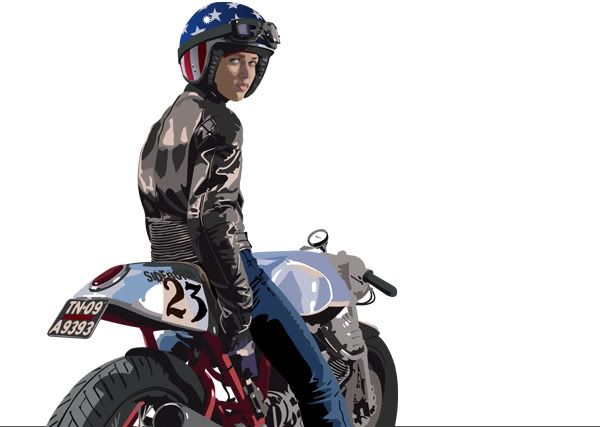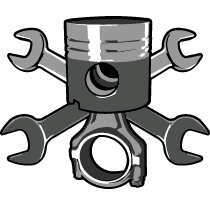Bullet in the head
I couldn't help notice the changes on the roads in India. The amount of people using them and the vehicles they chose.
Because of the high import taxes on vehicles for years India had a small cast of immediately recognisable vehicles like the Padmini, Amdassdor, Chetak and Bullet. There was a comforting reassurance in their ubiquity. The fact that they were all models that had already had a full life in the West before the factory tools made their way to India to give them another shot. An *ahem* Indian Summer if you like, that meant they were always charming and retro to a visitor from Europe.
Deregulation, liberalisation and green policy is quickly changing the demography of India's roads. Delhi can still choke you with fumes but the auto-rickshaws seem to be entirely running on CNG (compressed natural gas) and it sure does make a difference. It's necessary for their survival, they used to pump out ferocious plumes of two-stroke smoke and the city appears to be serious about cutting emissions. The diesel Harley Davidson trikes (yes really) that used to ply their trade in the capital have disappeared, they were insanely polluting both with smoke and noise and presumably it was impossible to do anything realistic about it but it's always a shame to lose a characterful vehicle.
That is the crux of the looming problem that Royal Enfield is facing. Right now the Enfield is a great vehicle to use in India. It can cruise at a decent speed all day long, but it's no longer the fastest thing on the road. It's not just the new Mercs, Beemers and Jags that are starting to appear on India's roads that are quicker than a 500 Bullet. The much larger number of Maruti Suzuki (and similar) compacts can easily cruise faster than the bike that used to reign supreme. Right now it's okay, just remember to keep checking those mirrors on the highway for the small number of people going faster than you...
...but as the numbers increase it will become harder. The Bullet isn't really fast enough to ride in Europe any more. It's a great urban bike but the faster stuff leaves it breathless with the rider feeling bullied by traffic, lacking the motorcycle's usual trump card in extremis - a burst of acceleration to get you out of trouble. We put up with it because we are enthusiasts and as such are blind to the faults of our chosen marque or at least infinitely forgiving. But we could not recommend a Bullet to a colleague or in-law.
As India's roads become more crowded with nippy little cars this will increasingly become the case for the Bullet in India too. We might be indulgent enthusiasts in Europe who enjoy Enfields in spite of their shortcomings but it only exists because it is a decent ownership proposition and a reasonable value deal for the Indian rider. When that is no longer the case then the end of the Bullet won't be far away.
That's why I think Royal Enfield need to act now. They've proved in the past that they can update the Bullet to keep up with the times. The addition of electric start and fuel-injection may have appalled the traditionalists but was vital for survival, however the performance issue is even harder to solve.
I think they should be bold. Don't fuss around at the edges trying to squeeze a shade more performance from the Bullet lump, no. Make a twin! Gifted enthusiasts like Carberry (amongst others) have already proved the concept and using two existing 500 barrels they maximise the amount of shared parts with the 500 single. This wouldn't create a superbike, but it would certainly create a bike capable of holding it's own again in Indian traffic now and for the foreseeable future. Enfield would have a halo product and enthusiasts the world over would be interested I'm sure in a brand new 'vintage' 1000cc 'British twin'. What's not to love? Enfield shouldn't just make this motorbike... I don't think they can afford not to.
Labels: Cars, Enfield, India, Motorbikes






3 Step to the white courtesy phone:
supra shoes
kate spade uk
christian louboutin outlet
chaussure louboutin
polo ralph lauren
belstaff
michael kors handbags
nike roshe run
moncler outlet
p90x workouts
north face uk
coach outlet canada
ralph lauren uk
adidas shoes
nike free runs
gucci
nike roshe run women
kate spade
new balance outlet
louis vuitton pas cher
soccer shoes
nike air huarache
cheap ray ban sunglasses
longchamp outlet
vans shoes
ralph lauren pas cher
true religion jeans
abercrombie and fitch
cheap oakley sunglasses
swarov ski jewelry
michael kors
2015912yuanyuan
September 12, 2015 4:16 am
fila disruptor
off white clothing
off white shoes
longchamp bags
off white clothing
kd 10
adidas nmd
ray ban aviator sunglasses
off white
nike air huarache
August 07, 2018 2:52 am
fila
custom baseball jerseys
longchamp bags
john wall shoes
converse shoes
coach outlet store
jordan retro
huarache shoes
lacoste polo shirts
michael kors handbags sale
September 26, 2018 5:43 am
Post a Comment
<< Home